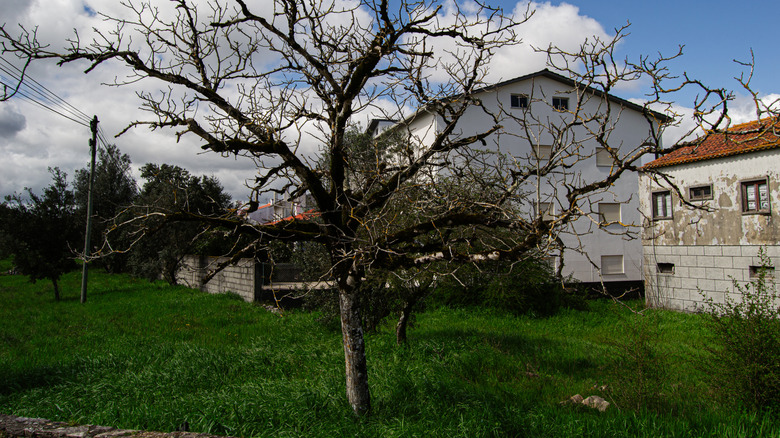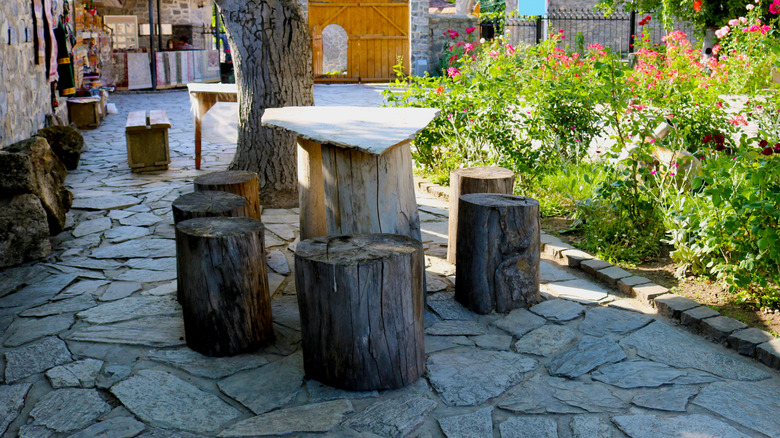The Benefits Of Leaving A Dead Tree In Your Yard That You May Not Know
With its bare limbs and weathered bark, that dead tree might look like more of a liability than anything useful. But what looks like dead weight could actually be one of the most valuable parts of your landscape. When left standing, a dead tree becomes an unexpected asset to the environment around it. Birds like woodpeckers are drawn to it first, creating nesting spaces in the softened wood. Once they move on, other animals like owls, squirrels, and even raccoons take over the space.
Upright dead trees, called snags, are especially useful because they provide shelter that's high off the ground and out of reach from most predators. In fact, more than 1,200 wildlife species in the U.S. depend on already dead or decaying wood for food, shelter, or nesting. Beyond wildlife, dead trees also help your yard by slowly releasing nutrients into the soil and even helping to trap carbon.
Of course, not every dead tree is safe to keep. Before you leave the tree up (especially if it's unstable or leaning near your home) you'll want to consult a professional who can assess whether it's time to remove dead tree roots before they become a hazard. But when conditions allow, keeping that tree right where it is can be one of the most valuable choices you can make for your yard.
How dead trees improve your soil and support plant life
When a dead tree starts to break down, it's easy to think it's just cluttering the ground. But that slow decay is doing powerful work for the health of your soil and surrounding plants. Fungi are among the first to show up. Some species have the rare ability to break down lignin, one of the toughest components in wood.
Once that's done, the softer parts become accessible to other fungi, insects, and bacteria. As the breakdown continues, nutrients like nitrogen and carbon are released back into the soil, feeding nearby plants and encouraging new growth. Young saplings often sprout in the protective shade of these fallen giants, with rich, moist soil helping them take root.
Dead trees also play a role in controlling water flow. Their softened wood holds moisture, reduces the risk of erosion, and improves the soil's ability to retain nutrients. That makes them especially important during dry periods or in overworked landscapes. And from a climate angle, leaving large trees to rot naturally helps extend their role as carbon sinks, slowing the release of carbon dioxide into the air.
How to repurpose a dead tree if you don't want to leave it to rot
If letting a dead tree rot naturally doesn't suit your landscaping style, you're not alone. While there are clear ecological benefits to leaving it untouched, not everyone wants a decaying trunk front and center in their yard. The good news is, you don't have to choose between beauty and function. With a little creativity, that same tree can still serve a purpose, just in a more polished, intentional way.
One option is to keep the trunk standing and use it as a garden feature. Some homeowners choose to attach birdhouses to trees that are still standing, turning the trunk into a support for pollinator homes or nesting boxes. Others dress it up with climbing vines or seasonal decorations. Even simple touches, like making garden statues or hidden details among the bark, can make the space feel designed rather than neglected.
If you'd rather remove the tree but still make use of the wood, there are plenty of practical ideas. Turn thick sections into benches, carve out planters, or lay cross-sections as stepping stones through your garden. You can also break down the bark and smaller branches to create mulch, giving back nutrients to the soil in that same spot.


